
by Penny Angeles-Tan | Sep 16, 2024 | Discounts, Sales, and Giveaways
The Manila Hotel is ushering in the holiday season early with its Christmas Hamper early bird offer. From
September 16 to October 31, 2024, guests can enjoy a special 20% discount, a privilege reserved for our early bird shoppers, on thoughtfully assembled gift baskets brimming with festive treats and signature goodies.
This year’s hampers are a celebration of our rich cultural heritage, inspired by the Filipino salakot, a traditional headgear that adds a unique touch to our holiday celebrations. This limited offer gives patrons a head start on their holiday shopping, ensuring they can share the joy of the season with beautifully presented gifts that reflect our shared traditions.
Our Standard Hamper, priced at ₱2,304 (regularly ₱2,880), is a delightful mix of Bahay Kubo Gingerbread, Christmas Cookies, Fruitcake, Harana Pralines, Cashew Raisin Cluster, The Manila Hotel Facade Chocolate Bar, and a Santa with Bag Chocolate. It’s just one of the three exciting options we have for you.
The Deluxe Hamper, available for ₱5,504 (regularly ₱6,880), offers an elevated collection featuring Bahay Kubo Gingerbread, Pili Nut Pralines, Fruitcake, Food for the Gods, Mango Nut Cluster, Santa with Bag Chocolate, Christmas Cookies, Bugnay Wine (375 ml), and a Willy the Bear Stuffed Toy. It also includes a Regular Prestige Card for added perks.
Finally, the Premium Hamper, priced at ₱7,280 (regularly ₱9,100), is the ultimate indulgence, offering Harana Pralines, The Manila Hotel Facade Chocolate Bar, The Manila Hotel Blend Coffee Drip, Bugnay Wine (375 ml), Tablea (250 g), a Tsokolatera Pot with Wooden Whisk, The Manila Hotel Tumbler, Ilang-Ilang Notebook, Willy the Bear Keychain, Willy the Bear Stuffed Toy, and a Regular Prestige Card.
Pick-up of orders starts on November 1, 2024. For orders and inquiries, call Delicatessen at +632 8527-0011 or +632 5301-5500 local 1125, or email re************@************el.com.
Terms and conditions apply.
Per DTI Fair Trade Permit No. FTEB-201376 Series of 2024.
The Manila Hotel is situated next to kilometer zero (0), the starting point of the City of Manila, and is just a short walk away from the Philippines’ renowned landmarks: Rizal Park, Intramuros, and National Museums.
With a rich history, sophisticated ambiance, and top-notch service, The Manila Hotel is the preferred choice for esteemed guests. Since 1912, The Manila Hotel has consistently offered exceptional services and amenities for a truly unforgettable stay. It boasts over 500 well-appointed rooms and 22 function rooms, including three (3) ballrooms. Additionally, the hotel provides five-star relaxation and wellness experiences with the Manila Hotel Spa, adult and children’s pools, and the Manila Hotel Health Club.
The hotel is home to the Heritage Museum, which houses invaluable artifacts that recount its illustrious past. It also features an Art Gallery that provides a glimpse into the contemporary world through the distinct perspectives of various artists.
With six (6) dining outlets, The Manila Hotel offers a diverse culinary experience: Café Ilang-Ilang is a popular spot known for its extensive selection of international buffet delights; Champagne Room, with its elegant Old European-style fine dining, is hailed as the most romantic room in Manila and features European cuisine in a luxurious setting; Tap Room is an Old English pub-inspired outlet where guests can enjoy live music in the evenings; Lobby Lounge is ideal for casual dining, aperitifs, post-dinner drinks, or informal meetings; Red Jade is a fine dining restaurant offering authentic Chinese cuisine; and Delicatessen offers the hotel’s signature pastries, bread, chocolates, and pralines.

by Penny Angeles-Tan | Sep 12, 2024 | Business
Hamster Kombat has set a listing date of September 26. Read to the end of this article to understand how to take part in the Hamster Kombat airdrop and everything about the HMSTR listing at the end of September.
Hamster Kombat has set a listing date of September 26. Ahead of the listing, Hamster Kombat announced that it had reached 55,000,000 users on its Telegram channel.
This article covers everything you need to know to maximize your HMSTR airdrop revenue. Read to the end of this article to understand how to take part in the Hamster Kombat airdrop and everything about the HMSTR listing at the end of September.
Hamster Kombat Price Prediction After Listing
Hamster Kombat gained immense popularity. User enthusiasm for this game is still high today. Hamster Kombat is even expected to achieve success beyond the DOGS listing.
Not surprisingly, there are more than 150 million Hamster Kombat users, making Hamster Kombat the tap2earn game with the biggest income in the web3 industry. Its Telegram followers have increased to more than 55 million users.
Having failed to list several times according to the planned date, Listing Hamster Kombat finally set September 26 as the listing date as Bitrue also will be listing HMSTR/USDT market.
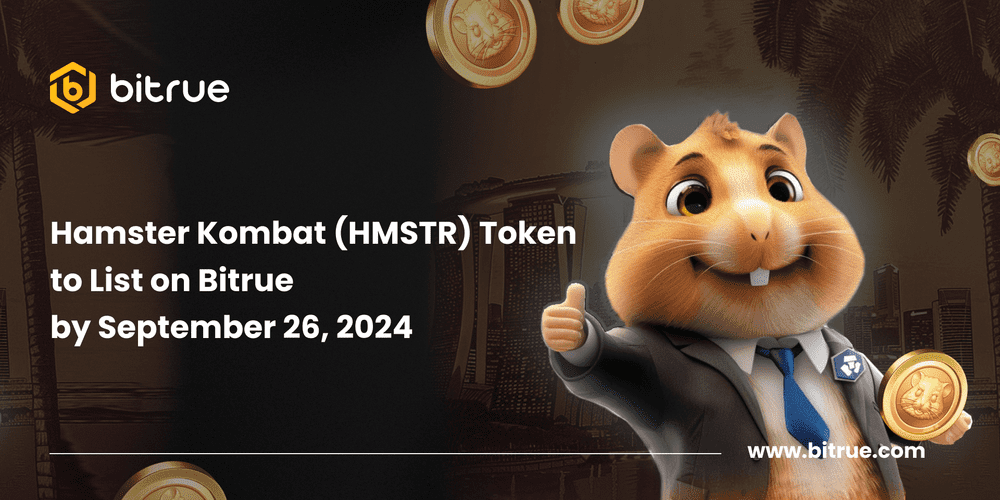
This news certainly makes fans of this hamster-themed game happy.
Following the official listing date announcement for Hamster Kombat, many price predictions emerged. It is estimated that the total supply of HMSTR tokens is 100,000,000,000.
Quoted from holder.io, with an average market capitalization of $785,000,000, the estimated price of the HMSTR token is $0.00785. So, the predicted value of the HMSTR token is between $0.007 and $0.01.
How Can You Participate in the Hamster Kombat Airdrop?
The Hamster Kombat airdrop will launch alongside the listing date on September 26th. After a lot of speculation and predictions about the requirements for taking part in the Hamster Kombat airdrop, finally, several points for taking part in this airdrop event have been released.
In the Airdrop tab, Hamster Kombat has set several tasks to get an airdrop. However, the amount of profit allocated from these tasks has not yet been announced.
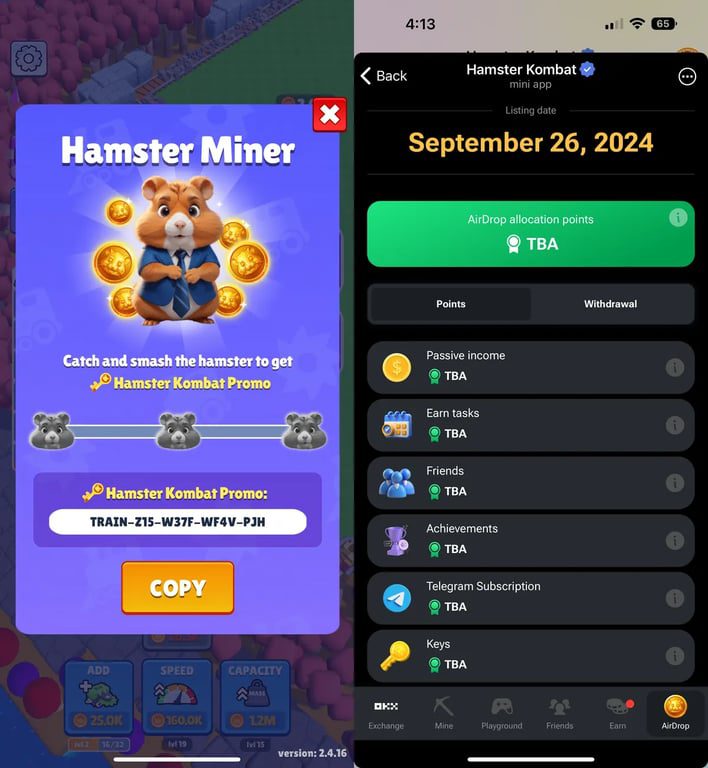
Some of the tasks include passive income, earning tasks, friends, achievements, Telegram subscription, and keys.
Keys is a requirement that is a little surprising because the function of this feature was not announced since its initial appearance. To get more keys, you can play the Hamster Kombat Mini Game and other games at the Hamster Kombat Playground.
Cheating Detection with “Cheating is Bad”
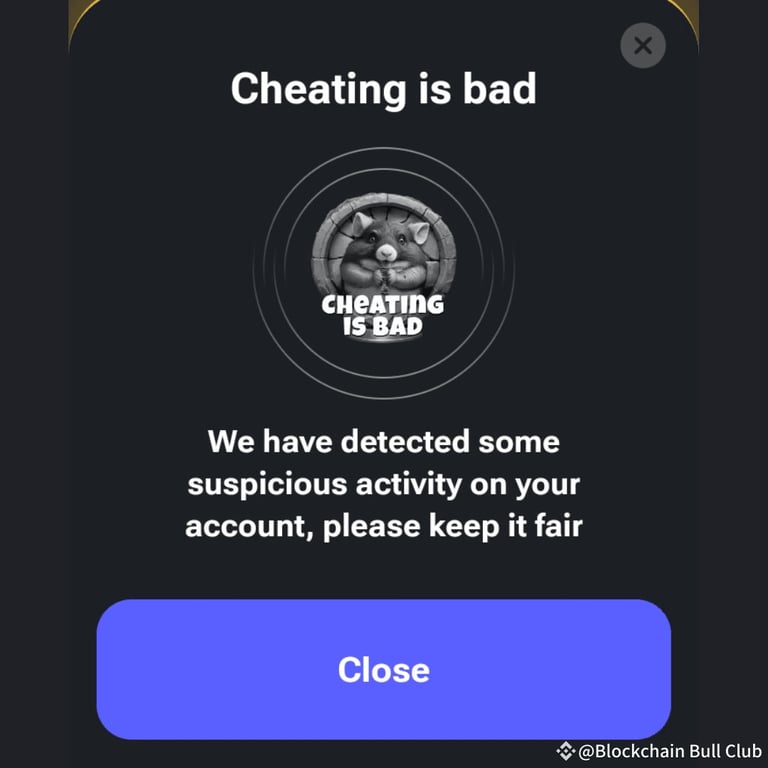
It is rumored that there will be a lot of cheating at the airdrop event on September 26, until the launch of the Hamster Kombat mini-game so far, the Hamster Kombat developer has released the Cheating is Bad feature.
This feature will detect how players commit cheating or other unethical actions. Later, if a player is judged to have cheated, a badge will appear on his profile.
The badge will display a green tick which means the player’s account is being monitored. If fraud continues to be detected, the account can be suspended or blocked.
To celebrate the upcoming listing of Hamster Kombat (HMSTR), Bitrue is launching an exclusive airdrop giveaway. All users who complete trading or invitation tasks can receive HMSTR tokens worth up to 20 USDT

Conclusion
Those are the various things you need to know about the Hamster Kombat listing on September 26. With the listing approaching, keep playing the Hamster Kombat game to get more points and keys to maximize your airdrop earnings later.
Bitrue provides many leaked answers to various Hamster Kombat tasks, such as mini-games, daily combos, to daily chips. So, don’t forget to access it blog Bitrue to read the article about Hamster Kombat.
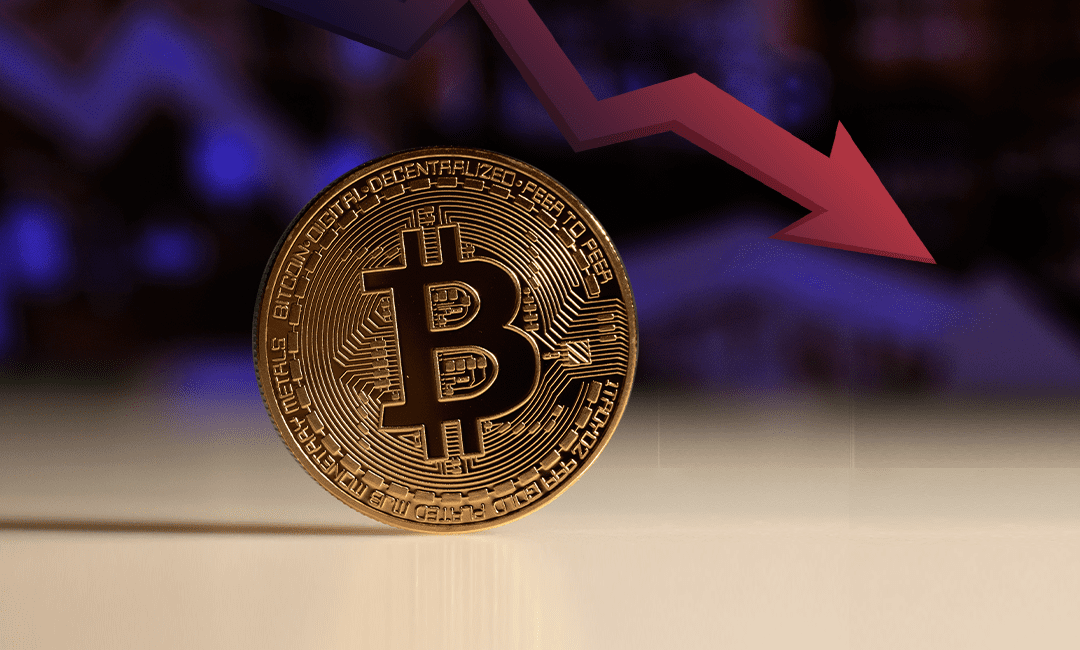
by Penny Angeles-Tan | Sep 11, 2024 | Business
On-chain analyst Ali Martinez has recently issued an important warning regarding the current Bitcoin market conditions. Based on a two-month chart analysis, the TD Sequential indicator, commonly used to identify potential turning points in market trends, shows concerning sell signals. This signal suggests a possible reversal from the bullish trend that has recently strengthened. This warning comes amidst ongoing uncertainty in the crypto market, where sharp price fluctuations have become commonplace.
Martinez explains that the $51,000 support level is critical for investors to watch. If Bitcoin falls below this level, there is a significant risk that the price could continue to decline, potentially reaching $40,600. Such a decline could result in substantial losses for investors who have not taken preemptive measures. This prediction underscores the importance of the $51,000 support level in maintaining Bitcoin’s price stability and highlights that the crypto market remains highly volatile and susceptible to drastic changes. Martinez advises investors to remain vigilant and consider the risks associated with the current market uncertainty.
A drop below this support level could have a significant impact on Bitcoin (BTC) and potentially affect the broader crypto market. If BTC fails to maintain this critical support level, increased selling pressure could lead to further declines, not only impacting Bitcoin’s price but also potentially causing a domino effect on other crypto assets. This impact could create instability across the market, reduce investor confidence, and trigger panic selling.
Currently, Bitcoin is trading at $54,630, reflecting a 3.54% decrease over the last 24 hours, according to CoinMarketCap data. This price drop reflects market concerns about Bitcoin’s ability to hold its key support level. The high volatility and negative sentiment surrounding this price drop emphasize the need for caution among investors. Given the potential widespread impact of this decline, it is crucial for market participants to closely monitor price movements and market sentiment in the coming days.
CryptoPotato reports that over the last five trading days, the crypto market experienced a massive outflow of $277.2 million. This situation has further exacerbated the market’s existing pressures. The outflow reflects investor concerns and uncertainties, leading them to withdraw their funds from the crypto market. Despite various influencing factors, the sheer volume of this outflow indicates a significant lack of confidence in the current market stability.
Interestingly, this event occurred despite September 2 being a national holiday in the United States. National holidays are generally expected to provide some respite from market pressures, but this time, the situation was different. The large outflow still occurred, signaling that investor uncertainty and concerns are not limited by regular trading days. This highlights the fragility of current market sentiment and how global factors can influence investment decisions even during trading activity breaks.
Overall, this report underscores the importance of understanding market dynamics and factors that can influence short-term price movements. Market participants need to stay alert and be prepared for potential volatility resulting from these massive outflows. It also serves as a reminder for investors to continuously monitor the latest developments and make investment decisions based on thorough analysis.
During this period, investors made substantial withdrawals in several days. On Tuesday, they withdrew $287.8 million, followed by $37.2 million on Wednesday. Withdrawals continued with $211.1 million on Thursday and reached $170 million on Friday. Among the entities affected, FBTC Fidelity recorded the largest losses, adding to the market’s existing burden.
The total outflow during this period reached a significant $706.1 million, extending the negative streak to eight consecutive days. This is the longest recorded period of decline, indicating deep concerns among investors and impacting the overall market stability. The continuous withdrawal trend reflects widespread uncertainty and the potential long-term impact on the dynamics of the crypto market.
For novice traders looking to start investing in Bitcoin, now might be an opportune time. You can track Bitcoin prices through the Nanovest app, which offers a comprehensive selection of crypto assets. Nanovest provides up to 600 crypto asset options and allows investors to start with a small capital of just 5,000 rupiah.
If you’re interested in crypto asset investment, Nanovest could be a suitable choice as it offers over 2,000 U.S. stocks and more than 600 crypto assets. Take advantage of the current market movement by investing through Nanovest! For those interested in using Nanovest, the app is available on both the Play Store and the App Store.

by Penny Angeles-Tan | Sep 11, 2024 | Business
DOGS’ reputation is growing day by day. Will DOGS become more successful in the crypto industry? Learn more about DOGS future predictions in this article.
As a new meme coin, DOGS’s reputation is increasingly strengthening in the crypto ecosystem. DOGS becomes the top 3 crypto with the most unique holders. This number is considered fantastic because the tokens with more holders than DOGS are only USDT and ETH.
So, will DOGS continue to be successful in the crypto ecosystem? Is DOGS’s performance worthy of long-term investment? This article will discuss it, especially for you. Watch until the end to learn about DOGS developments in the crypto ecosystem.
DOGS Latest Achievements
Recently, the TON community announced that as many as 17 million users claimed DOGS tokens. This achievement is quite impressive for a new meme coin like DOGS.
According to Tonviewer, more than 5 million wallets are holding DOGS tokens on the TON blockchain. With this amount, DOGS has become a meme coin with a fantastic number of unique holders.
With that many holders, DOGS can only be surpassed by USDT from Tether and Ethereum (ETH).
Throughout its existence, DOGS now has more than 53 million users on its mini app with more than 42 million users eligible for airdrop claims.
With this achievement, the TON Community has more hope in Catizen and Hamster Kombat which is predicted to be able to compete with the success of DOGS now.
DOGS, Meme Coin Leader?
DOGS has many fans. Its release on crypto exchanges is much anticipated. However, the release schedule which coincided with the incident of Pavel Durov’s arrest meant that the DOGS price performed beyond user expectations.
Crypto News Flash reports that DOGS is gaining tremendous traction among meme coins. It was recorded that as of September 10, DOGS had increased by 9%. Staking DOGS also attracts more and more users.
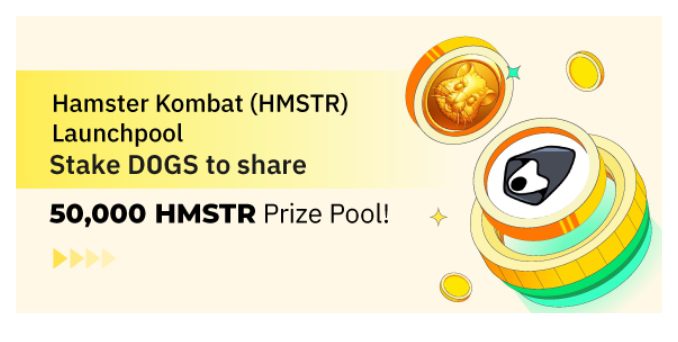
For additional information, you can get prize of 50,000 HMSTR tokens by staking DOGS on Bitrue. The requirements are very easy. You only need to verify KYC on your Bitrue account, make a deposit with a minimum nominal, then you can redeem at any time.
As of September 11, DOGS had declined by 4.63%. Now, DOGS is trading at $0.0010112. Previously, DOGS was at $0.0010855 as its highest price in the last 24 hours.
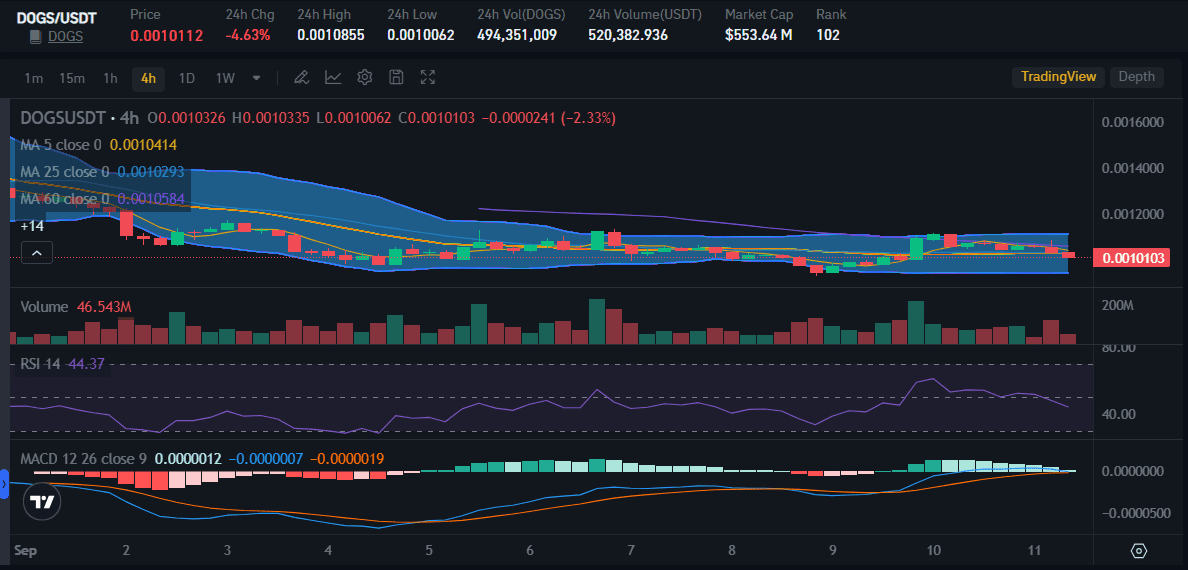
In the price chart above, the RSI line is at 46. A number below 50 indicates that the DOGS selling trend is higher than the buying trend.
However, DOGS holders can be a little optimistic about DOGS performance because the MACD line seems to be trying to rise upwards. It could be said that DOGS has the possibility of being bullish even though it is currently in the red.
Will DOGS Continue to Be Popular in the Crypto Ecosystem?
The important question now is, will DOGS continue to establish itself as a meme coin with strong value in the crypto ecosystem?
Since its inception, DOGS has become a favorite among Telegram fans and the TON Community. DOGS continues to be in demand even when Bitcoin and the majority of Altcoins experience price declines.
When Bitcoin fell to $54,000, DOGS rallied with an increase of up to 16.5%. However, will this positive DOGS trend continue in the future?
Yang pasti, like any other cryptocurrency, DOGS is subject to various factors that can influence its price. Here are some of the key factors, such as:
1. Market Sentiment and Speculation
Positive news, hype, and fear of missing out (FOMO) can drive up the price of DOGS. Negative sentiment or news can have the opposite effect. Discussions and trends on social media platforms like Twitter and Reddit can significantly impact the price of DOGS.
2. Supply and Demand Dynamics
The distribution of DOGS tokens among holders can affect price. A concentrated ownership can lead to higher price volatility, while a wider distribution can stabilize the price.
The availability of buyers and sellers in the market can impact price. Higher liquidity generally means more stable prices.
3. Technological Developments and Project Progress
Positive developments in the DOGS project, such as new features, partnerships, or milestones achieved, can boost investor confidence and drive up the price. Improvements in the DOGS blockchain’s scalability and performance can enhance its utility and attract more users, potentially increasing the price.
Conclusion
That is information related to DOGS becomes the top 3 crypto with the most holders. The number of holders can only be surpassed by USDT and ETH, making DOGS a meme coin that is quite worthy of consideration at the moment.
You can read other information related to DOGS and various other crypto ecosystem news updates only on Bitrue. Only on the blog Bitrue, you can get the latest news related to cryptocurrency which can be read anytime and anywhere for free!

by Penny Angeles-Tan | Sep 9, 2024 | Business
The Manila Hotel is honored to be recognized as the Philippines’ Leading Hotel at the World Travel Awards 2024. This esteemed accolade reaffirms the Grand Dame’s unwavering commitment to providing world-class Filipino hospitality to guests from around the globe. Often regarded as the “Oscars of the travel industry,” the World Travel Awards celebrate excellence in tourism and hospitality.
“We are thankful to the World Travel Awards for this recognition,” said The Manila Hotel president Atty. Jose D. Lina, Jr. “To our cherished guests and patrons, this victory is yours as much as it is ours. Your continued support and loyalty inspire us to keep delivering the exceptional service you’ve come to love. We also extend our congratulations to the Department of Tourism for their achievement in winning Asia’s Leading Marketing Campaign award for the ‘Love the Philippines’ campaign. We also commend DOT Secretary Christina Garcia Frasco for being recognized with the Transformational Leadership in Tourism Governance award, underscoring her outstanding contributions to Philippine tourism. Mabuhay ang industriya ng turismo ng Pilipinas!”
The Manila Hotel’s vice president for sales and marketing Marvin Kim Tan also stated, “We are delighted to receive this recognition from the World Travel Awards. This award reflects the dedication and passion of our team, whose commitment to excellence ensures that every guest experiences the heart of Filipino hospitality. It celebrates not just our rich heritage but the legacy we continue to build.”
As an iconic national heritage institution, The Manila Hotel offers guests a blend of historical significance and modern amenities while providing world-class accommodations, dining, wellness, and recreational services.
About The Manila Hotel
 The Manila Hotel is located beside kilometer zero (0), where the City of Manila begins, and is within walking distance from the Philippines’ known landmarks: Rizal Park, Intramuros, and National Museums. Defined by its history, elegance, and world-class service, The Manila Hotel is the choice hotel for the most distinguished clientele.
The Manila Hotel is located beside kilometer zero (0), where the City of Manila begins, and is within walking distance from the Philippines’ known landmarks: Rizal Park, Intramuros, and National Museums. Defined by its history, elegance, and world-class service, The Manila Hotel is the choice hotel for the most distinguished clientele.
Since 1912, The Manila Hotel has continuously provided the best services and amenities for a truly memorable experience. It has more than 500 well-appointed rooms and 22 function rooms, including three (3) ballrooms. Apart from these, the hotel offers five-star relaxation and wellness experiences with the Manila Hotel Spa, adult and children’s pools, and the Manila Hotel Health Club.
The hotel is home to the Heritage Museum, a treasure trove of priceless memories that narrate its illustrious past. It also has an Art Gallery that offers a window into a contemporary world, captured through the objective point of view of different artists.
It has six (6) dining outlets, each offering a unique culinary adventure: Café Ilang-Ilang, which is a favorite spot for its extensive selection of International buffet delights; Champagne Room with its Old European style fine dining and also hailed as the most romantic room in Manila—it features European cuisine in a posh, fine-dining setting; Tap Room, an Old English pub-inspired outlet where one can enjoy an evening of live music; Lobby Lounge which is ideal for casual dining, aperitif, post-dinner nightcaps, or leisure meetings; Red Jade, a fine dining restaurant that serves authentic Chinese cuisine; and Delicatessen that offers the hotel’s signature pastries, bread, chocolates, and pralines.
















 The Manila Hotel is located beside kilometer zero (0), where the City of Manila begins, and is within walking distance from the Philippines’ known landmarks: Rizal Park, Intramuros, and National Museums. Defined by its history, elegance, and world-class service, The Manila Hotel is the choice hotel for the most distinguished clientele.
The Manila Hotel is located beside kilometer zero (0), where the City of Manila begins, and is within walking distance from the Philippines’ known landmarks: Rizal Park, Intramuros, and National Museums. Defined by its history, elegance, and world-class service, The Manila Hotel is the choice hotel for the most distinguished clientele.












You must be logged in to post a comment.